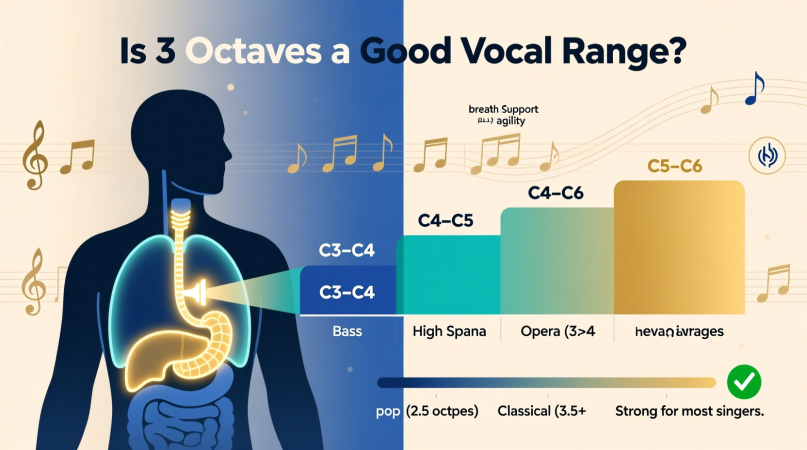
Many singers dream of expanding their vocal range, but few stop to ask: what’s actually considered “good”? If you can sing across three octaves, you might be wondering whether that puts you above average—or if it’s still not enough compared to professionals who claim four, five, or even six octaves. Let’s explore what three octaves really mean, how they compare with averages, and what you can do with them.
What Does “3 Octaves” Mean in Singing?
An octave is the distance between one note and the next note of the same name, either higher or lower in pitch. For example, going from C3 to C4 is one octave.
If you can sing across three octaves, your range might look like this:
- From C3 (low) up to C6 (high), or
- From A2 to A5, depending on your natural placement.
It’s important to note that your usable range (notes you can sing clearly and consistently) matters more than your extreme highs and lows. A singer who can only squeak or whisper at the edges may “technically” have three octaves, but in practice, their working range is smaller.
Is 3 Octaves Above Average?
Yes—three octaves are above the average for most singers.
- Untrained voices: 1.5 to 2 octaves.
- Trained singers: Often 2.5 to 3 octaves.
- Exceptional professionals: 4–5 octaves or more.
So, if you have three usable octaves, you’re already above what most singers achieve.
👉 To see where you stand, try an online vocal range checker.
Why a 3-Octave Range Is Considered Good
Versatility Across Styles
Three octaves allow you to comfortably sing pop, rock, musical theater, and even some classical roles.
A Sign of Vocal Training
Reaching three octaves usually means you’ve developed chest voice, head voice, and possibly falsetto.
Beyond the Average
Compared to most hobbyists and casual singers, three octaves give you a big advantage.
Challenges of Having 3 Octaves
- Not every note is equal: Some parts of your range may sound weaker.
- Genre limits: Some advanced opera roles and powerhouse pop songs demand wider ranges.
- Maintenance required: Keeping three octaves healthy means consistent training.
Famous Singers With About 3 Octaves
Plenty of legends fall in this category:
- Adele – around 2.5–3 octaves
- Elton John – roughly 3 octaves
- Whitney Houston (usable range) – about 3 octaves
- Freddie Mercury – just over 3
This proves that three octaves can still deliver timeless performances.
Comparison Table of Vocal Ranges
| Range Span | Level | Typical Example | Notes |
|---|---|---|---|
| 1.5–2 octaves | Average | Casual singers | Limited repertoire |
| 2–2.5 octaves | Good | Hobbyists, choir | Can handle pop songs |
| 3 octaves | Above average | Adele, Elton John | Strong versatility |
| 4+ octaves | Exceptional | Mariah Carey, Axl Rose | Rare and advanced |
Expanding Beyond 3 Octaves
Many singers aim to grow further, but expansion must be safe and gradual.
Techniques for Growth
- Glides & sirens – slide between registers smoothly.
- Strengthening passaggio – train transitions between chest and head voice.
- Incremental practice – add one semitone at a time.
- Never force it – straining risks injury.
👉 You can measure your progress using a vocal range calculator tool.
Tone vs. Range: Which Matters More?
Big ranges get attention, but they don’t guarantee musical greatness. Tone, artistry, and control matter far more. In fact, many songs sit within just one octave.
Three consistent, beautiful octaves are often more powerful than five shaky ones.
FAQs on 3-Octave Vocal Range
Is 3 octaves a good vocal range?
Yes—above average and enough for most styles.
Can I expand beyond 3 octaves?
With steady training, some singers grow to 4 octaves or more.
What’s the average vocal range?
Between 1.5 and 2 octaves.
Do I need 4+ octaves to succeed?
Not at all—many icons thrived with 3 or less.
Who has the widest vocal range?
Mariah Carey, Axl Rose, and Tim Storms are often cited for extreme ranges.
